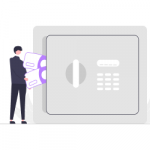In today’s competitive market, a compelling customer experience is the only thing that helps any product company stand out. However, creating a winning CX is no easy endeavor. Jennifer Lund, our guest expert from SuperOffice AS, is ready to share her thoughts on how to leverage journey mapping for improving user experiences.
To learn her expert opinion, you can read the article or watch the video at the bottom of the article.
Contents
A recipe for a great customer experience
There is no shortage of ways to describe what a good CX is, but essentially they all come down to this: a customer experience is about making customers feel special.
“Do what you do so well that they will want to see it again and bring their friend,”
Walt Disney, Founder of Disney
A great example of the matter at hand is Disneyland. The reason behind this place’s magic is that customers are made feel special across every touchpoint — from social media to website to chat and customer service. This is particularly remarkable as Disneyland is huge with thousands of people coming every day.
From the business perspective, investing in high-quality customer experiences yields positive returns, with 86% of buyers willing to pay for a great CX, according to PWC. So, how do you make those customers feel special and have a positive experience? Through the customer journey.
Сustomer journey channels
When it comes to customer journey mapping, there are a lot of channels to consider. Some may fall into the trap of focusing on a single channel, whether it is social media, email, or others. However, the key is to understand what customers want at every stage of their journey, and for that, you need all channels to flow seamlessly together.
Case example: SuperOffice
In a large organization, CJM may be challenging as there are a lot of different people and different opinions. At SuperOffice, for example, there are seven countries with a mix of centralized and local functions. So, not only do we have to create a single customer experience across the central functions, but we also have to do it in the local subsidiaries.
Being a CRM company, SuperOffice is very customer-focused. There were specific processes in place for sales, services, and customer experience, but none for marketing.
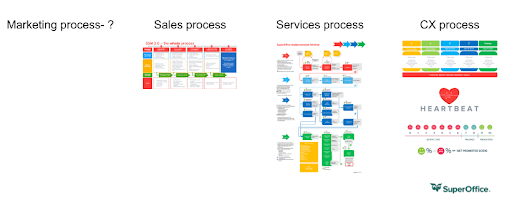
Mistakenly, we focused on doing a lot of different activities that we thought were best for our customers. We mixed channels, content types, and messages, resulting in confusion and disjointed activities.
To understand what was essential to our customers, we needed to change our way of thinking and break away from the inside-out mindset, i.e., focusing on me, my product, and what I think is good for the customer. Instead, we needed to shift our attention to customer needs, insights, and values and adopt an outside-in approach.
Mapping the customer journey
As mentioned earlier, a customer journey is all about touchpoints at different stages. What you need to focus on is the gap between what you provide to your customers at these stages and what your customers actually want.
There are four stages of customer journey mapping.
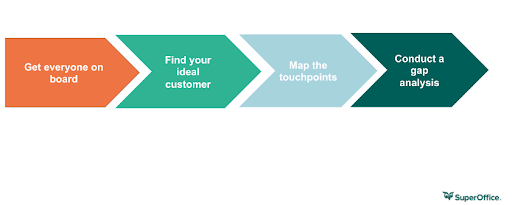
It starts with getting everyone on board — services, sales, customer experience team, support. And for that to happen, it’s crucial to have management to back you up. The next step is to find your ideal customer as the world is not our oyster and we need to be hyper-targeted. Then you need to map different touchpoints and conduct a gap analysis, keeping in mind the outside-in strategy.
At SuperOffice, we had to do mapping both centrally and locally. When preparing for a journey workshop with each country, we sent a slide deck with the following information:
- Overall objectives of the process
- Target groups and characteristics
- Customer journey overview and phases
- Mapping the local customer journey touchpoints as they are today
- Gap analysis and prioritization
During the workshop, we put up a customer journey base model without any colors. And then we put down a customer mindset for each phase. At the trigger phase, we had potential buyers who realized they had a pain and wanted to figure out what they needed. For that, they would seek knowledge, inspiration, and advice.
You can use the following template (more CX templates) to fill out the details about a customer mindset, touchpoints, and where you are today.
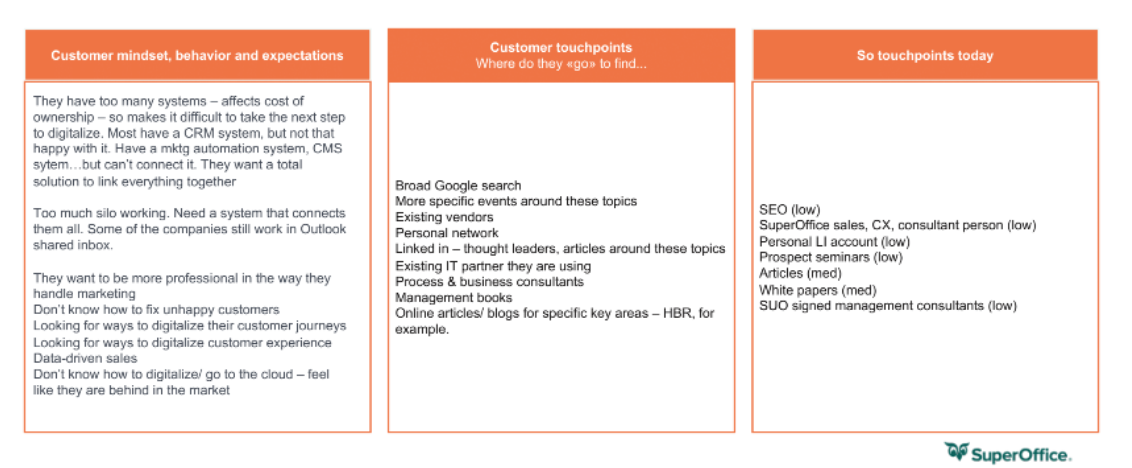
The result was a detailed view of what touchpoints were important for our customers and how much work we actually put in there. By aligning these columns, we could find the gaps and analyze them.
And since we didn’t have unlimited resources and time, we mapped how much effort something would take from low to high and how much we would get out of it to understand what to focus on.

The gap analysis is the most important exercise because it helps you pinpoint what activities you should spend your time on. Once we did the gap analysis and identified the necessary actions across all touchpoints, we got a template that looked like this.
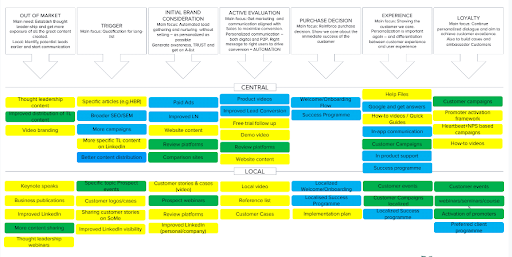
As a result, we discovered that we had a lot of great content, but we had problems getting the right content to the right person at the right time and through the right channel. So we started a project to sew together the entire digital customer experience.
For another example of how a digital marketing journey map can aid advertising campaigns, check out an expert article by Hallgeir Gustavsen.
We also created a marketing process that was focused on finding the target market and the ideal customer.
Key takeaways: journey mapping in marketing
Customer journey mapping is a powerful tool that helps brands become more customer-centric and drive better user experiences. Key points to remember to get the most out of your CJM process:
- The world is not your oyster, so it’s crucial to know your target audience;
- Think outside-in, rather than outside-out;
- Choose the channels that make the most impact and use your resources on those channels;
- Always keep improving.
Pro tip: You must have executive buy-in for this to work across the entire organization.
Business benefits of the customer journey
From the business perspective, customer journey mapping goes a long way. Below are the findings from the Aberdeen Research that you can use to gain support from your stakeholders.
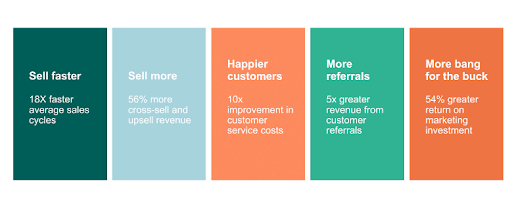
Q&A session
How were the personas built for the project?
The persona building process began right after we finished the content journey. We based our personas on market research, buyer research, NPS survey, and our own CRM database. Since we operate in a middle-size B2B market, our personas include CEOs, sales managers, marketing managers, customer service managers, and support managers.
How did you engage teams from different departments?
It’s super important to have management back-up. By continuously bringing CX as part of the conversation, we managed to raise awareness and get all departments on board.
If you have to do journey mapping from scratch, where would you start?
If you don’t have sales, service, and CX processes in place, it’s still recommended to start with marketing because that’s where you meet your customers. You can sew together some touchpoints and messaging for the target market, and then move that over into sales as they need to keep with the customer experience when communicating with buyers.
Did you have actual customers involved in this process or was it carried with internal staff?
The trigger process is based on buyers and not customers. But when we came to the second side of the journey, we had customer feedback that we used.
What would you do differently if you wanted to do it again?
The “keep improving” part. There are places where we need to go back and check them to see what we are missing.
How often do you revisit a journey map to keep it a living, breathing document?
Depending on your organization size, you can revisit the journey map yearly or more often.
What would you change if you were working with a different type of company, for example, a startup building a mobile app like Uber?
If we are looking only at the mobile app, it would be a much smaller scale. We would build a profile of a target customer, their mindset, why they are using the app, etc. Then we would draw the journey with that data.
If we are looking at the entirety of Uber, it would be the whole thing with mapping journeys for sales, marketing, and service support.
If you have multiple personas, would you build two separate maps?
I wouldn’t want to overcomplicate things and I’d use the same map but still be very cognizant of who I'm speaking to when I'm creating the piece of content. That’s a challenge because when you say you want to sell only to CEOs, it’s important to remember that CEOs just sign checks, and the person you need to target is the influencer — individual contributors like sales managers, customer service managers, and marketing managers.
Journey mapping in marketing: video
We had a pleasure listening to Jennifer at our recent online event. Watch the recording below:


